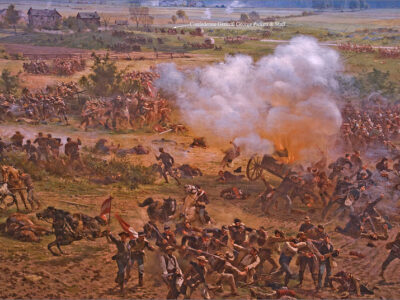From smartphone apps that help us find our favorite kitschy roadside attractions to 3-D films that seem to put us right in the middle of the action, technology has become such a part of our road trip experiences these days that it often makes us wonder what people did before we had all of these modern conveniences.
So what did people do back before all these newfangled gadgets came along?
Well, back in the late 19th and early 20th centuries, they went outside to their local parks, visited dime museums, and if they were lucky enough to live in a big city, they went to see a cyclorama. A cyclorama is a large, circular painting that’s often hundreds of feet in length. Viewers stand in the center to get the feeling that they are part of the 360-degree circular scene. (Think of them as the precursor to the modern IMAX.)
Cycloramas were introduced back in 1787 when Irish painter Robert Barker captured the panoramic view of Edinburgh, Scotland’s Calton Hill and displayed his painting in the very first cyclorama building. Afterwards, they became popular throughout the 19th century, when almost every major European and American city had one.
Most cycloramas in America depicted famous battles — like Eugene Bracht’s Battle of Chattanooga and Battle of Little Bighorn — and often included a narrator, music, and dioramas placed in front of them to give a more realistic “depth” to the painting.
With the advent of movie theaters, the popularity of the cyclorama waned by the early 20th century. However, among the dozen or so that still exist, two cycloramas from the 1800s are still on display.
For those of you who would like to add a cyclorama to your next road trip itinerary, here’s where you can see some great works of this panoramic art.
Gettysburg National Military Park
1195 Baltimore Pike, Gettysburg, PA
In 1882, French artist Paul Philippoteaux visited the town of Gettysburg. A year and a half after making sketches of the town’s surrounding battlefield and interviewing veterans of the battle, he unveiled his cyclorama painting, The Battle of Gettysburg, in Chicago to much acclaim.
Paul Philippoteaux’s cyclorama became so famous, in fact, he was commissioned to make another for Boston, which he unveiled in 1884. This is the one on display at the Gettysburg Battlefield today. After surviving years of exhibition and touring, vandalism, a fire, and general neglect, it finally came home to Gettysburg in 1913. It was purchased by the National Park Service and restored in 1942, and again from 2004 to 2008.
Today, the painting depicts the battle’s third day of fighting; Pickett’s ill-fated charge features a landscaped foreground and dramatic sound and lighting effects. All of this creates somewhat of a 3-D effect that can make visitors today feel they somehow time-traveled back to that fateful July afternoon.
The secrets to this painting? Well, we won’t divulge all of them, but keep an out for Abraham Lincoln, “ghost” soldiers, and even Philippoteaux himself.
Atlanta History Center
130 West Paces Ferry Rd, Atlanta, GA
This 42-foot x 358-foot cyclorama was on display in Grant Park for over 126 years until it was moved to its present location at the Atlanta History Center in 2019. The Battle of Atlanta was created in Milwaukee, WI, by 17 German immigrants, 22 years after the battle took place. Reported to be the largest oil painting in the world, it is complemented by a diorama and music, and it is narrated in five languages.
It was first painted to show the heroic Union victory of the Battle of Atlanta so that Northerners would find it appealing. However, once the cyclorama came to Atlanta in 1892, some changes were made to the painting, and it was billed as “the only Confederate victory ever painted,” to appeal to Southerners who still held on to their Confederate sympathies.
Call it false advertising. Call it an 18th-century version of fake news. Whatever you call it, the truth is that Confederates were not victorious in the 1864 Battle of Atlanta. As a result, in the 1930s, the modifications were changed back to their original state.
By the way, the final cost to move the cyclorama from Grant Park to a new building at the Atlanta History Center in 2019? Nearly $36 million.
One of the secrets of the painting is that one of the dying soldiers once resembled Clark Gable. This was done at the actor’s request after touring the cyclorama during the premiere of Gone with the Wind with co-star Vivien Leigh. Today, however, Mr. Gable has been painted out and now plays the part of a smiling mannequin lying on the floor of the diorama.
~~~
No trip to a cyclorama would be complete without making a Stuckey’s stop along the way. So the next time you’re out on the road, circle around to your nearest Stuckey’s location and check out our wide selection of road trip snacks, including our world famous Stuckey’s Pecan Log Roll, savory flavored pecans, mouthwatering popcorn, and all the classic candy brands you remember.

And because it also wouldn’t be a Stuckey’s stop without browsing through all of the kitschy souvenirs you remember, too, don’t forget to pick up a couple of our Stuckey’s branded t-shirts or trucker caps for the folks back home.
Go to stuckeys.com to browse Stuckey’s merchandise and have it delivered just in time for your next road trip.
Stuckey’s – We’re Making Road Trips Fun Again!
Whether your next road trip is by car or by rail, it’s not really a road trip without taking Stuckey’s along. From our world famous Stuckey’s Pecan Log Rolls to our mouthwatering Hunkey Dorey, Stuckey’s has all the road trips snacks you’ll need to get you where you’re going.
For all of the pecany good treats and cool merch you’ll need for your next big road adventure, browse our online store now!
Stuckey’s – We’re Making Road Trips Fun Again!

